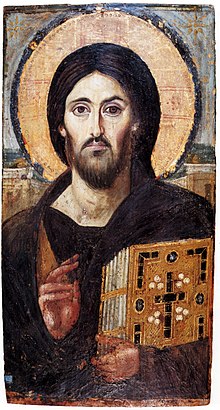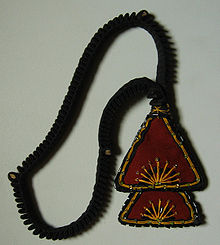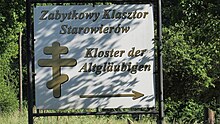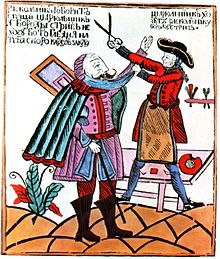Old Believers in Russia




Old Believers ( Russian староверы even Old Ritualists , старообрядцы, Old Believers , древлеправославные or derogatory Raskolniki , раскольники, apostates or splitter ) is a term for different Christian directions and Communities in Russia, which no longer since 1667 Russian Orthodox Church included. The Old Believers turned against the reforms of the Patriarch Nikon , who from 1652 reformed texts and rites of the Russian Orthodox church services. They are divided into priestly (поповцы) and priestly (беспоповцы) Old Believers.
Today there are Old Believer communities in Russia, Romania , the United States and other countries.
history
Reforms 1652
In 1652, Patriarch Nikon initiated the first reform of the Russian rite. It has been claimed that the Russian rite deviated from the original Greek text and rite as a result of errors in copying church records. This position served as a justification for Nikon and his supporters to carry out church reforms.
In the following years, numerous smaller communities emerged who rejected the reforms and retained the old rite ( priestly Old Believers ).
Synod 1666/67
At a synod in 1666 and 1667, the Russian Orthodox Church decided to exclude these communities and anyone else who rejected the reforms and banned them from the Church ( anathema ).
Other communities emerged that diverged considerably from the norms of the Orthodox Church by rejecting the priesthood, the sacraments and other doctrines ( Old Believers without priests ).
Persecutions and exile
Opponents of these church reforms were now persecuted and tens of thousands were executed . In order to avoid persecution by the authorities, the Old Believers often withdrew to remote areas of the Russian Empire or abroad and formed their own communities there.
Persecution did not decrease until the middle of the 18th century, but many discriminatory laws remained. The Old Believers still had no civil rights. In 1905 the situation of the Old Believers became legal.
Scientific research on the rite of the Old Believers in the 19th century
In the second half of the 19th century, scientists from the Imperial Academy of Sciences discovered that the Old Russian rite did not actually deviate from the Old Byzantine rite, but that the Greek rite had gradually changed under the influence of various factors in the 13th and 14th centuries . This process explained the difference between the Russian and Greek rites in the mid-17th century. The reviewers included Professors A. Dmitrijewski, E. Golubinski from the Moscow Spiritual Academy, as well as N. Kapterew and A. Kartaschow. In 1971 the large church of the Moscow Patriarchate lifted the ban on the Old Russian rite.
The best-known representative and one of the founders of Old Believer ownership is the protopope Avakum , whose autobiography is an important testimony to Russian literature of the 17th century.
Most important liturgy changes
The following changes to the liturgy under Nikon are cited as the most serious by the Old Believers:
| Old Russian liturgy | Nikon's liturgy | |
| Nicene Creed | рождена, а не сотворена ( created but not created) ; И в Духа Святаго, Господа истиннаго и Животворящаго (And to the Holy Spirit, the true Lord who gives life) | рождена, не сотворена (made, not made) ; И в Духа Святаго, Господа Животворящаго (And to the Holy Spirit, the Lord who gives life) |
| cross sign | Two fingers straight, three curved | Three fingers straight, two curved |
| Number of Prosphora (communion loaves ) in the Eucharist | Seven Prosphores | Five Prosphores |
| Direction of the procession | With the course of the sun (clockwise) | Against the course of the sun (counterclockwise). |
| Alleluia | Аллилуїa, аллилуїa, слава Тебe, Боже (Twice Hallelujah) | Аллилуїa, аллилуїa, аллилуїa, слава Тебe, Боже (Three Hallelujahs) |
| Spelling of the name of Christ | І сусъ (Isus) | Іи сусъ (Iisus) |
There are also different spellings in literature (e.g. the formulation of doxology ) and church chant.
Especially in the past, the position of the Old Believers was often portrayed as a rigid, fanatical belief in rituals, which resulted in the meaningless suffering of tens of thousands. It was claimed that the reforms only concerned external, ritual aspects and that the Old Believers were unable to distinguish the trivial from the main. The Old Believers objected that the content of belief could not be separated from the form. At that time, many believers were of the opinion that by “cursing” the old rite and the old texts, they touched the truths of faith that had been clad in certain rituals since the first centuries, and thus touched the essence of faith. In order to maintain a microclimate in which man can save his soul, it is not only necessary to obey the commandments of Christ, but also a careful preservation of the church tradition, which contains spiritual powers and spiritual experience of many centuries, the forms of which, although outwardly but not be arbitrary or accidental .
Directions within the Old Believers
Priestly
The priestly Old Believers (Поповцы, Popovzy ) represented the conservative and moderate opposition, they strived for a continuation of the church life, as it had existed before the reforms. They accepted priests from the official church who wanted to join them, and were thus able to acquire priests for themselves and thus keep the sacraments . The churches of the priestly Old Believers do not deviate from the orthodox faith in theological terms.
- Onuphrios Community ( Onufrievščina , Онуфриевщина ), also Avvakum Community ( Avvakumovščina , Аввакумовщина )
- Semeiskije ( family ), ( Semejskie , Семейские ), also Tschasowennyje ( Časovennye , Часовенные , from Часовня - chapel)
Priestless
The theology of the priestless (Беспоповцы, Bespopowzy ) is characterized by an anti-clerical and apocalyptic mood. The priestless claim that the Antichrist has already come into the world, not physically, but “in spirit”, and that the true Church no longer exists on earth. They therefore believe that there is no longer a valid priesthood and therefore no longer celebrate the Eucharist . They reject the official Orthodox Church and the state associated with it, because these too are viewed as instruments of the Antichrist.
There were many directions within the priestless Old Believers:
- Aaronowzen
- Get started
- Chlysten
- Fedosejewzy (“Society of Christian Old Believers of the old unmarried denomination of the Pomorje”, from 1690 to today): You refuse marriage and lead an ascetic, monastery-like life.
- Netovzen or Spassowo soglasie . The name is derived from the Russian word net ("no"). They deny the possibility of sacraments, the priesthood and congregational celebrations in a church building.
- Philipponen : Founded by a monk Philipp, this branch spread to East Prussia .
- Pomors or Danilowzen originally refused marriage and prayer for the tsar.

Todays situation
Priestly Old Believers
The priestly Old Believers comprise two separate hierarchies: the Old Believers of the Belaya Krinitsa hierarchy and the Novosybkov hierarchy. The following eparchies exist in these two churches:
- The Russian Lipovan Orthodox Old-Rite Church (Russian Русская православная старообрядческая церковь), even hierarchy of Belaya Kriniza , has twelve dioceses, eleven of which are located on the territory of the former Soviet Union, one is in Germany: Moscow , Kiev and the Ukraine , Kishinev and Moldova , Novosibirsk and Siberia, Yaroslavl - Kostroma , Saint Petersburg - Tver , Nizhny Novgorod and Vladimir , Kazan - Vyatka , Don and Caucasus , Urals , Far East . In 2004 the church had 146 local parishes and a monastery. This church fully restored the ecclesiastical hierarchy in 1846 when the Greek Bishop Amwrossi joined it. Since the division of Bukovina in 1940, the church has been led by two metropolitans , one based in Moscow and one based in Brăila in Romania , in the vicinity of which (mainly in Tulcea ) an old Orthodox Lipovan minority still lives today.
- The Russian Old Orthodox Church (Russian Русская Древлеправославная Церковь), also the hierarchy of Novosybkow : This church also restored its hierarchy in the 1920s and is led by the Patriarchate of Moscow and all of Russia , it currently has four bishops in addition to the Patriarch Belarus and Ukraine , Siberia , Volga , Zion and Western Europe . The church has two convents for women and one for men. In 2004 it belonged to 74 parishes.
Old Believers without priests
Nowadays the Pomors are organized as the Old Orthodox Pomoric Church ( Russian Древлеправославная Поморская Церковь ). In 2004 the church had 42 parishes. You accept the marriage.
Old Believers in Russian Culture
literature
The stories of Nikolai Leskov are of interest to the knowledge of the Old Believers . Rich, although not always objective, material on the Old Believers can be found in the novels In the Forests (Russian В лесах; 1871–1875) and In the Mountains (Russian На горах; 1875–1881) by Pawel Ivanovich Melnikow (1818–1883) . Melnikov, who as an official persecuted the Old Believers for part of his life, saw in these novels in their religious community the embodiment of the religiosity of the Russian people and the salvation from nihilistic lack of faith. The book Die Vergessenen der Taiga by Vasily Peskow describes the story of the old believing Lykow family in the lonely Sajan Mountains , where the family lived completely isolated from the outside world in the Soviet era from 1945 to 1978. In 2012 Agafja Lykowa was still living alone in her wooden hut on the Abakan .
music
The theme is based around the Old Believers also an important element in the opera Khovanshchina by Modest Mussorgsky .
See also
literature
Non-fiction
- Peter Hauptmann : Russia's Old Believers. Vandenhoeck & Ruprecht, Göttingen 2005, ISBN 3-525-56130-X .
- Peter Hauptmann: Old Russian belief. The struggle of the Protopope Avvakum against the church reforms of the 17th century. Vandenhoeck & Ruprecht, Göttingen 1963.
- Peter Hauptmann: The Russian Old Believers under Soviet religious oppression 1917–1941 . In: Christoph Gassenschmidt, Ralph Tuchtenhagen (Ed.): Politics and Religion in the Soviet Union, 1917–1941 . Harrassowitz, Wiesbaden 2001, ISBN 3-447-04440-3 , pp. 47-63.
- Ф. И. Мельников: Краткая история древлеправославной (старообрядческой) церкви. Изд-во БГПУ, Барнаул 1999; ISBN 5-88210-012-7 , (FI Melnikow: Brief history of the old orthodox (old ritualistic) church. Barnaul 1999, Russian).
- Alexandr Varona: Tragedia schismei ruse. Reforma patriarhului Nikon şi începuturile staroverilor. Editura Criterion, Bucharest 2002; ISBN 973-26-0702-5 ( The tragedy of the Russian schism. The reform of the Patriarch Nikon and the beginnings of the Old Believers. )
- SA Senkowsky: Russia's Old Believers. Fink, Munich 1970. Russian edition: Русское старообрядчество. Moscow 1995, 2006 (1st and 2nd part), ISBN 5-93311-012-4 .
Fiction
- Wassili Peskow: The forgotten of the taiga. Goldmann Pocket Books, 1996, ISBN 3-442-12637-1 .
- Pawel Ivanovich Melnikow : In the woods. Union Verlag, Berlin 1970.
Web links
- glossary
- Website of the Old Believers in Samara ( Memento of October 7, 2007 in the Internet Archive ) With materials on Old Orthodoxy (Russian)
- Website of the Old Believers in Tambov With materials on Old Orthodoxy (Russian); is not automatically adjusted under Mozilla for correct playback click View / Character encoding Windows Cyrillic (1251)
- The website of the Russian Old Orthodox Church (Russian)
- Website of the Old Orthodox Church of Pomorje in Saint Petersburg (Russian)
- Website of the so-called Philipponen, the Old Believers expelled from Russia to Poland (detailed information in German)
- Website of the Old Believers living in Estonia (English, Estonian, Russian)
Individual evidence
- ↑ Heinz-Gerhard Zimpel: Lexicon of the world population. Geography - Culture - Society . Nikol Verlagsgesellschaft mbh & Co. KG, Hamburg 2000, ISBN 3-933203-84-8 , p. 442 .
- ↑ AV Pankratov: Ot Vostoka napravo ( to the right from the East ), Moscow 2000; Pages 28, 29
- ↑ a b S. W. Bulgakow: Sprawotschnik po jeresjam, sektam i raskolam (reference work on heresies, sects and church divisions); Moscow: Sovremennik 1994 ( Memento of March 13, 2014 in the Internet Archive )
- ↑ Mstislav Voskressensky: Православие и христианские разделения. (No longer available online.) St. Philaret Institute for Theological Studies, Moscow, archived from the original on September 27, 2007 ; Retrieved July 19, 2017 (Russian).
- ↑ SA Senkovsky, Munich 1970, Moscow 2006
- ↑ Presentation of the Church ( Memento of September 27, 2007 in the Internet Archive ) On: Website of the Old Believers of Samara
- ↑ Statistical data on the church ( Memento from July 12, 2006 in the Internet Archive ) On: Website of the Old Believers of Samara
- ↑ Statistical information on the church ( Memento from May 7, 2006 in the Internet Archive ) On: Website of the Old Believers in Samara Oblast (Russian)
- ↑ Botschenkow WW, "PI Melnikow (Andrej Petscherski): Weltanschauung, Works, Old Believers" Russian: Боченков В.В., "П.И. Мельников Андрей Печерский: Мировоззрение, творчество, старообрядчество ». Ржев, 2008, ISBN 978-5-87049-625-2


